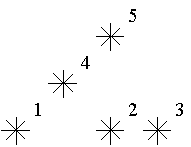Stars
| Time Limit: 1000MS | Memory Limit: 65536K | |
| Total Submissions: 49137 | Accepted: 21210 |
Description
Astronomers often examine star maps where stars are represented by points on a plane and each star has Cartesian coordinates. Let the level of a star be an amount of the stars that are not higher and not to the right of the given star. Astronomers want to know the distribution of the levels of the stars.

For example, look at the map shown on the figure above. Level of the star number 5 is equal to 3 (it's formed by three stars with a numbers 1, 2 and 4). And the levels of the stars numbered by 2 and 4 are 1. At this map there are only one star of the level 0, two stars of the level 1, one star of the level 2, and one star of the level 3.
You are to write a program that will count the amounts of the stars of each level on a given map.

For example, look at the map shown on the figure above. Level of the star number 5 is equal to 3 (it's formed by three stars with a numbers 1, 2 and 4). And the levels of the stars numbered by 2 and 4 are 1. At this map there are only one star of the level 0, two stars of the level 1, one star of the level 2, and one star of the level 3.
You are to write a program that will count the amounts of the stars of each level on a given map.
Input
The first line of the input file contains a number of stars N (1<=N<=15000). The following N lines describe coordinates of stars (two integers X and Y per line separated by a space, 0<=X,Y<=32000). There can be only one star at one point of the plane. Stars are listed in ascending order of Y coordinate. Stars with equal Y coordinates are listed in ascending order of X coordinate.
Output
The output should contain N lines, one number per line. The first line contains amount of stars of the level 0, the second does amount of stars of the level 1 and so on, the last line contains amount of stars of the level N-1.
Sample Input
5 1 1 5 1 7 1 3 3 5 5
Sample Output
1 2 1 1 0
Hint
This problem has huge input data,use scanf() instead of cin to read data to avoid time limit exceed.
Source
传送门:
点击打开链接
题意:就是给出若干星星的坐标,每个星星的级别数由有多少横坐标小于等于自己的星星个数,输出0到n-1级别数分别是多少
思路:这个题和树状数组很对口,直接根据横坐标更新就可以了(因为表示的结构正好就是树状数组的树形图)
分析完就是很裸的BIT
(简称了)模板
PS:这里的坑点是:一般BIT都是从1开始,但题目要求从0输出,在更新的时候要做一个+1的处理。这里容易WA
代码:
#include<iostream>
#include<cstdio>
#include<cstring>
#include<string>
#include<cmath>
#include<algorithm>
#include<vector>
#include<queue>
using namespace std;
typedef long long ll;
const int maxn=100010;
int ans[maxn];
int c[maxn];
int n;
int lowbit(int x){
return x&(-x);
}
void modify(int x){
while(x<=maxn){
c[x]++;
x+=lowbit(x);
}
}
int sum(int x){
int ans=0;
while(x>0){
ans+=c[x];
x-=lowbit(x);
}
return ans;
}
int main(){
int i,j;
int x,y;
scanf("%d",&n);
memset(c,0,sizeof(c));
memset(ans,0,sizeof(ans));
for(i=1;i<=n;i++){
scanf("%d %d",&x,&y);
modify(x+1);
ans[sum(x+1)-1]++;
}
for(i=0;i<n;i++){
printf("%d\n",ans[i]);
}
return 0;
}



 本文介绍了一道关于星图级别的统计问题,通过使用树状数组(Binary Indexed Tree, BIT)来高效地解决该问题。具体任务为,根据星星的坐标确定其级别,并统计各个级别的星星数量。
本文介绍了一道关于星图级别的统计问题,通过使用树状数组(Binary Indexed Tree, BIT)来高效地解决该问题。具体任务为,根据星星的坐标确定其级别,并统计各个级别的星星数量。
















 576
576

 被折叠的 条评论
为什么被折叠?
被折叠的 条评论
为什么被折叠?








